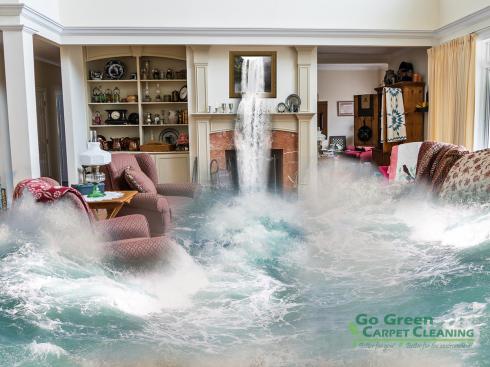<< Back to Blogs
1. Assess the damage.
Before you tackle clean up, know that severe damage usually requires professional help. Pros have heavy-duty equipment to remove water and the expertise to check for mold. Plus, any damage to walls and floors should be professionally repaired.
Typically, you'll be able to handle minor flooding yourself, but don't bother trying to save any items damaged by water containing raw sewage, oil or other waste; they'll need to be discarded.
2. Start clean up quickly.
To keep mold at bay, it's important to dry water-logged items (everything from furniture to small knick-knacks) within 48 hours. The longer they remain wet, the more likely mildew stains will appear. Begin by opening windows and using fans and dehumidifiers to keep air circulating.
3. Salvage and clean carpeting.
It's best to send removable carpets and area rugs out for professional cleaning. Unfortunately, installed carpeting (and the padding underneath) that's been immersed in water can't be adequately cleaned and should be thrown away.
If only part of your carpeting got wet, use a wet-dry vacuum to remove as much water as possible. Then, call in professional cleaners, or clean and rinse the carpet with an extraction cleaner (also known as a steam cleaner, like one of these machines we tested in the Good Housekeeping Research Institute). Use fans to speed the drying.
Depending on the extent of the damage, it may be necessary to pull the carpeting up to thoroughly dry the padding and floor. Plus, you may need to replace the padding to prevent mold. After cleaning and drying, spray with disinfectant spray, like Lysol.
4. Tackle furniture.
Take solid wood furniture outdoors, and remove drawers and doors to clean it (swollen parts may need to dry first if they can't easily be removed). Thoroughly brush or wash dirty furniture with a well-wrung cloth dipped in a mild soap and water solution. Use a cloth wrung in clear water to rinse. Allow the pieces to dry out of direct sunlight.
Badly damaged furniture may need professional refinishing, but others might just need a new coat of polish. Upholstered furniture should be professionally cleaned, and flood-damaged mattresses should be discarded.
5. Clean clothing — twice.
For washable fabrics, treat any stains with a prewash spray (we like Shout Advanced Gel) and wash in cool water with a powdered laundry detergent. Powdered detergents work well at removing clay and dirt that floodwater may contain, and cool water keeps stains from setting.
After this initial wash, re-launder everything, this time in the hottest water that's safe for the fabrics with powdered detergent and either chlorine or all-fabric bleach. Air dry all garments until you are certain any stains are removed. Take non-washable garments to the dry cleaner.
Source: Good Housekeeping

The Smart Way to Clean Up After a Flood
Posted July 26, 2017
With heavy rain pelting much of the country, and hurricane season in full swing, your home might be the next one to flood. Here's how to salvage (or toss) your flooring, furniture, and clothes after the water recedes.1. Assess the damage.
Before you tackle clean up, know that severe damage usually requires professional help. Pros have heavy-duty equipment to remove water and the expertise to check for mold. Plus, any damage to walls and floors should be professionally repaired.
Typically, you'll be able to handle minor flooding yourself, but don't bother trying to save any items damaged by water containing raw sewage, oil or other waste; they'll need to be discarded.
2. Start clean up quickly.
To keep mold at bay, it's important to dry water-logged items (everything from furniture to small knick-knacks) within 48 hours. The longer they remain wet, the more likely mildew stains will appear. Begin by opening windows and using fans and dehumidifiers to keep air circulating.
3. Salvage and clean carpeting.
It's best to send removable carpets and area rugs out for professional cleaning. Unfortunately, installed carpeting (and the padding underneath) that's been immersed in water can't be adequately cleaned and should be thrown away.
If only part of your carpeting got wet, use a wet-dry vacuum to remove as much water as possible. Then, call in professional cleaners, or clean and rinse the carpet with an extraction cleaner (also known as a steam cleaner, like one of these machines we tested in the Good Housekeeping Research Institute). Use fans to speed the drying.
Depending on the extent of the damage, it may be necessary to pull the carpeting up to thoroughly dry the padding and floor. Plus, you may need to replace the padding to prevent mold. After cleaning and drying, spray with disinfectant spray, like Lysol.
4. Tackle furniture.
Take solid wood furniture outdoors, and remove drawers and doors to clean it (swollen parts may need to dry first if they can't easily be removed). Thoroughly brush or wash dirty furniture with a well-wrung cloth dipped in a mild soap and water solution. Use a cloth wrung in clear water to rinse. Allow the pieces to dry out of direct sunlight.
Badly damaged furniture may need professional refinishing, but others might just need a new coat of polish. Upholstered furniture should be professionally cleaned, and flood-damaged mattresses should be discarded.
5. Clean clothing — twice.
For washable fabrics, treat any stains with a prewash spray (we like Shout Advanced Gel) and wash in cool water with a powdered laundry detergent. Powdered detergents work well at removing clay and dirt that floodwater may contain, and cool water keeps stains from setting.
After this initial wash, re-launder everything, this time in the hottest water that's safe for the fabrics with powdered detergent and either chlorine or all-fabric bleach. Air dry all garments until you are certain any stains are removed. Take non-washable garments to the dry cleaner.
Source: Good Housekeeping

